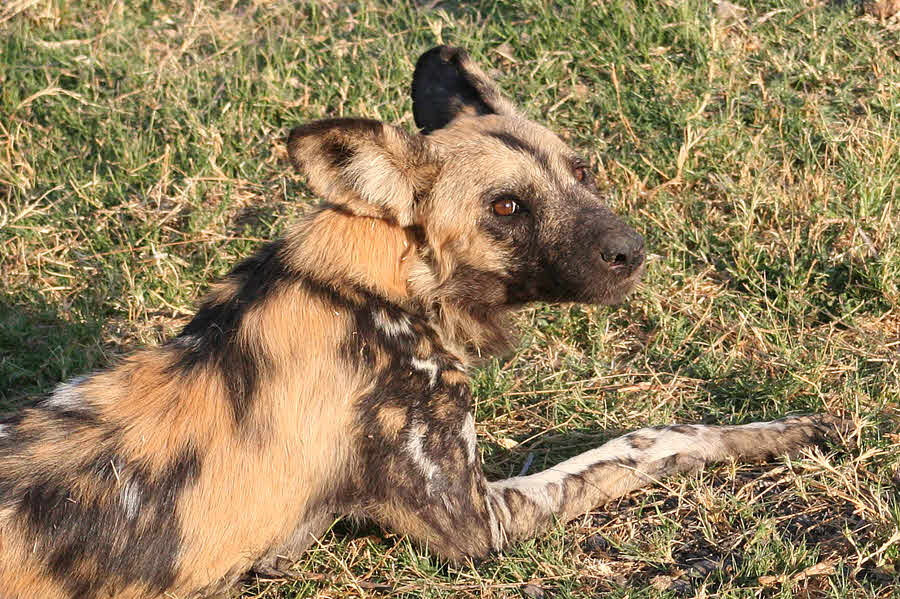
Go to Africa 2008 main page > > Okavango / Chitabe page

Photos and text, this page, © TK Boyd 11/08
Before I say more, I will mention that the African hunting dog, or wild dog, is in many ways like a sheepdog, i.e. a Border collie. The wild dog even has the white flag on the end of its tail. Those of you who know me will understand that they are thus already in my good books.
The pack we were lucky enough to encounter were coming to the end of their mid-day snooze when we came upon them.
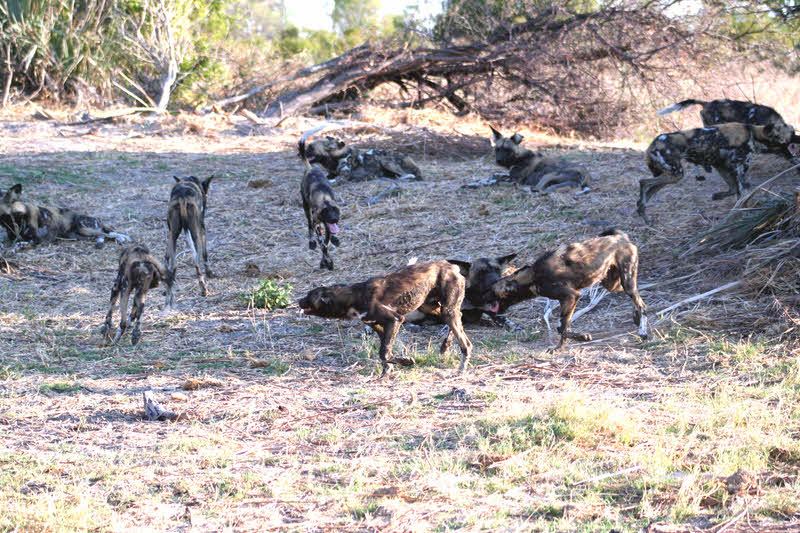
As the dogs rouse themselves, a boisterous play time ensues, during which everyone's place in the heirarchy is checked and reaffirmed. Play time started with some of the older members of the pack.
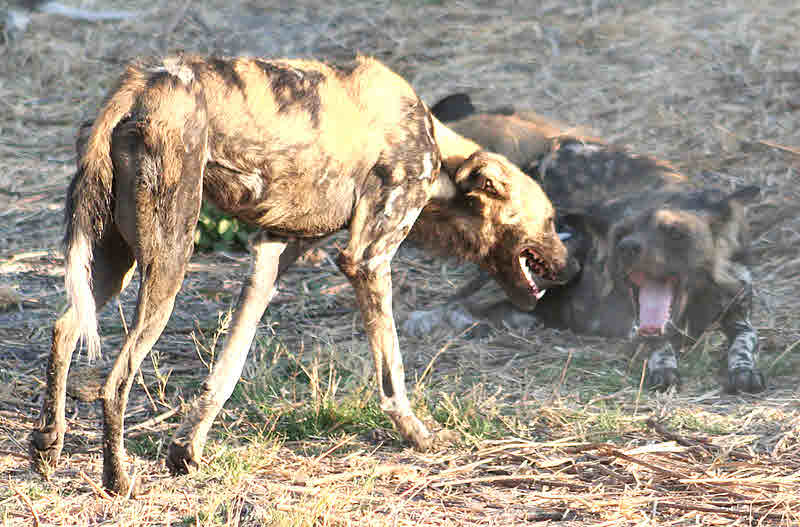
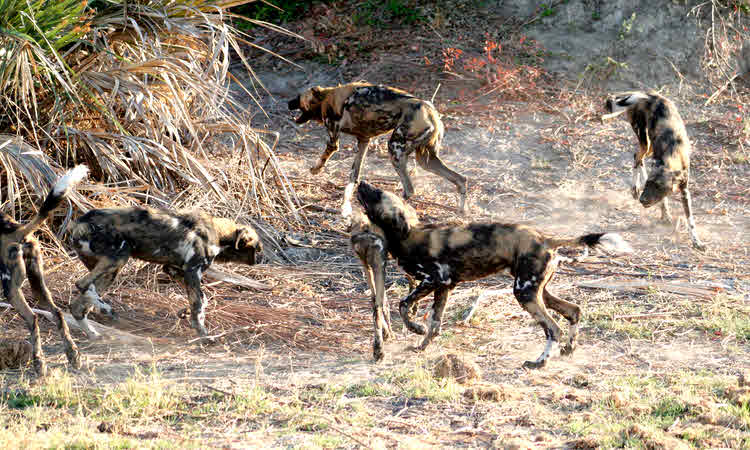
... but it wasn't long before the puppies appeared... they had been sleeping slightly apart from the others. There were 13 dogs in the pack. It was lead by a dominant pair, and I'm afraid I failed to record the other details... I think there were 6 puppies of this year, which would leave 5 other adults/juveniles. The puppies were, in human terms, about "ten years old". They had no trouble keeping up with the pack on the hunt.
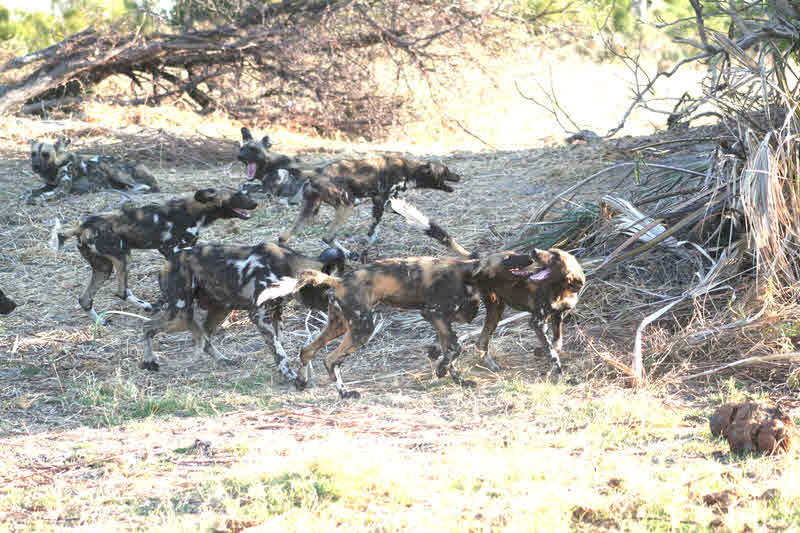
After play time, the pack became more serious, settling down to seeing what their noses could tell them about opportunities upwind.
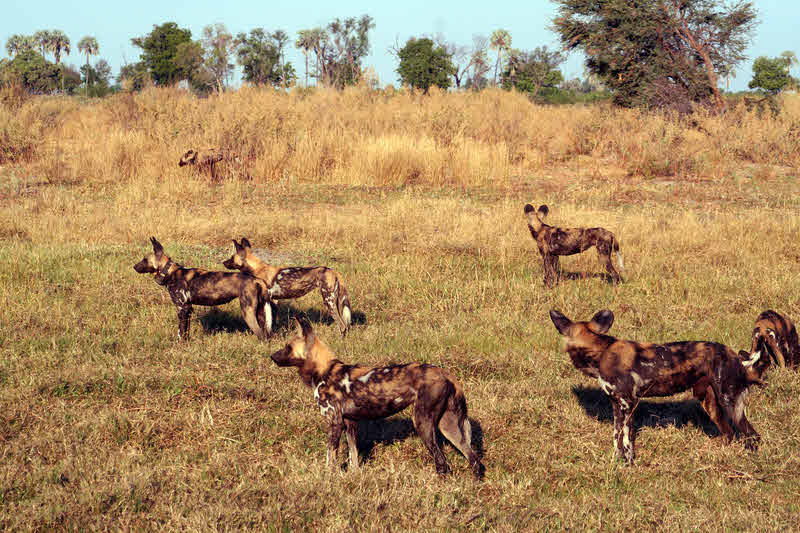
The pack set off across the grassland very purposfully.
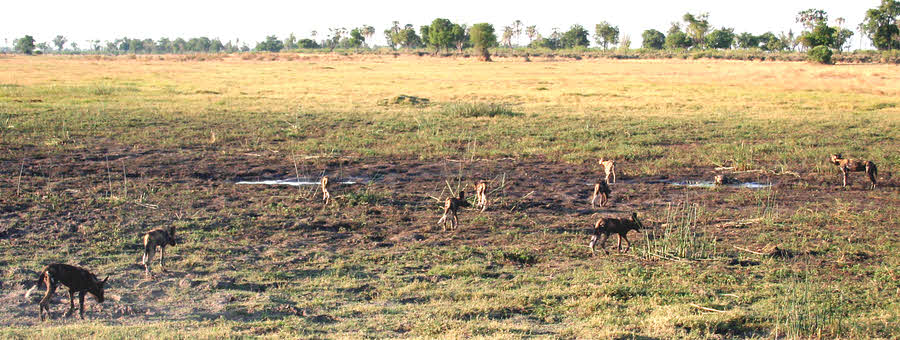
We followed along right behind, in our Land Rover. I was worried that this would distrub the dogs, interfere with their hunt. Remember that this is the first game drive of our trip (!), and I did not yet know how good our driver-guide was. Happily, we didn't seem to make much difference to the dogs.
This was not a good time or place to be an impala. Impalas are not a large antelope (100-180lbs. The dogs run 50-75lbs.), but they were very plentiful, both in the Okavango and at the other place we visited, Mfuwe in Zambia's South Luwangwa National Park.
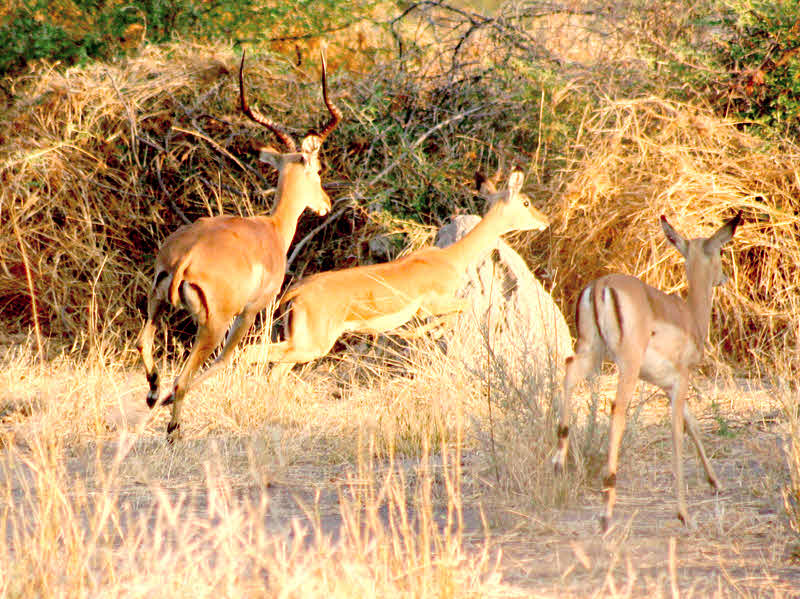
In the wide picture above, ahead of the dogs you can see a strip of trees. The dogs went into this, and we went left, around the end, expecting the dogs to come out. They didn't. Momentary panic.
Before I get back to what happened next, I need to set the scene. We'd already had a marvelous experience of the dogs. Not only that, but we were in the midst of one of the prettiest locations of the whole trip, with masses of game all around us at various distances. It was late afternoon, and stunningly beautiful.
... and our dog adventure wasn't over. Not by a long chaulk. What we'd seen so far was merely a little "strech of the legs". Having reached the strip of trees, the dogs lay down again for a moment. The last of the afternoon heat was still disappating, and dogs are not good with heat. The African hunting dogs'charming "Mickey Mouse" ears are, I believe, more about heat shedding than hearing.
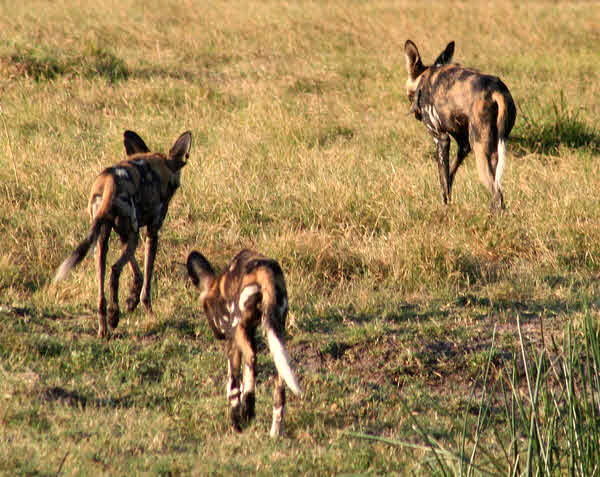
After their little rest, they set off again. This time, the tactical element was even more evident. While most of the pack continued to lope casually, but remarkably quickly, upwind in a loose line abreast, one dog soon established himself well to the right, and slightly ahead of the rest of the pack. He was clearly there to startle impala across the front of the main group.
Then it happened! The dogs had got close to some impala, and then one of them saw the "sweeper". The impala shot off in several directions, and one dog in particular became just a blur, chasing the antelope. It became difficult to keep track of all that was going on. I think at this stage the puppies were not keeping up for the moment.
And then a new development. It seemed that one of the dogs had got around in front of an impala, and was now driving it back towards the other dogs, but no... it wasn't interested in the impala anymore. At first, for a moment, we thought we were seeing blurs of a cheetah in the grass and scrub, but it turned out to be an adult leopard, who wasted no time at all in scooting up a tree to safety.
Meanwhile, about 300 yards back the way we'd all come, there was some other commotion around a medium sized acacia and a large clump of bushes about 30 yards from the base of the tree.
Many of the dogs were back there... the adult leopard had been treed by the fastest hunting dog, the one that had got out in front of the pack.
The adult leopard had not been alone. Back at the acacia, another leopard was treed... a cub, but well grown.
... and it nearly didn't get any older. For some reason, it came down from the tree, trying to make it to the bush. Simple inexperience? Seeking it's mother? (Or maybe for another reason that will become clear in a moment.) Anyway, it came down, made it almost all of the way to the bush (not a great defensive position, actually), and then, thankfully, in the nick of time reconsidered it's plan and shot back to and into the tree... just in the nick of time. The image of the leopard scooting up the tree, the swirling, excited dogs arriving at the base of the trunk just a whisker too slowly, the late afternoon sunlight catching the thrown up dust will be in my mind for a very long time.
And thankfully, the cub didn't have any more moments of foolishness, and stayed up the acacia this time. It would have been no match at all for the pack.
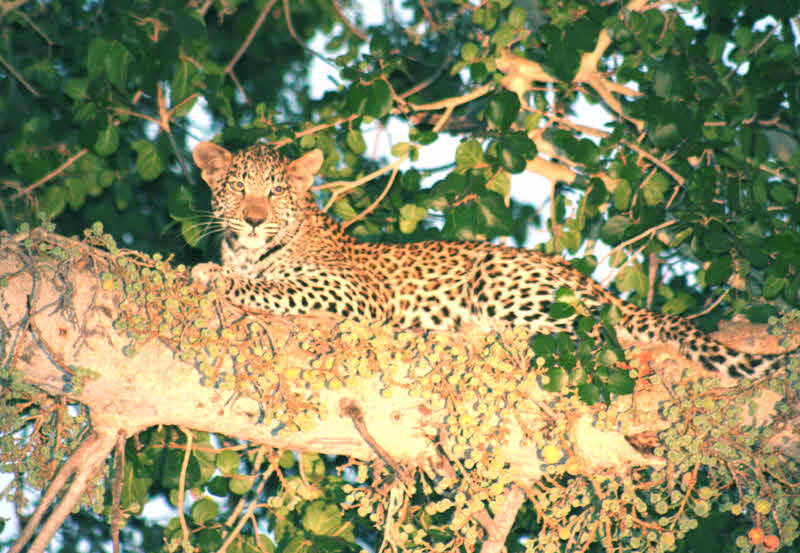
(Notice, by the way, the heavy crop of fruit in the tree... which I suspect are figs, which means that I need to go back, change all the references to "acacia" in this? And, gnash-teeth, gnash-teeth, as I write this I realise I have no photo showing an overview of where all this took place. I hope a fellow participant can help me with that.)
So- we had an excited pack of dogs, two leopards (110-180lbs), and some impala by now in the next county. We settled down to wait and see what would happen next. Everyone was having a bit of a "time out" / "catch our breaths" moment.
And then we realised that there were quite a few dogs "missing".
Eventually, we went around to the other side of the bush.... and found the missing dogs....
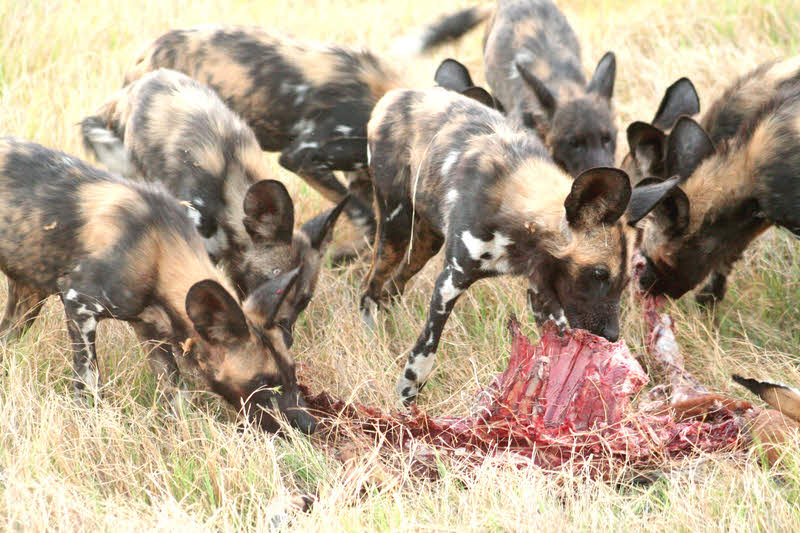
It was mostly the puppies, feasting on an impala which had probably been killed by the leopard. It may have been what caused the cub to so- nearly- disaterously come out of the tree. Gradually some of the older dogs drifted along to the scene of the feast, but they seemed content to leave it to the pups.
So... a pretty remarkable first drive... and there was more to come, related elsewhere.
It is worth re-capping that it is not easy to see the dogs. It is certainly a rare priviledge to see them hunt, both for the tactics of the stalk, and the incredible speed of the final attack. But to see them, in the midst of attacking impala, stumble on two leopards?
You may have seen the wild dog sequence which is a highlight of one episode of Sir David Attenborough's "Planet Earth"? It was filmed in the same area as our exceptional experience.
Also, although the dogs do occur in other parts of the Okavango, the owners of Chitabe, Dave and Helene Hamman, have done many years of research on the dogs, and championed them.
At http://www.okavango.it/camps/chitabe.htm, we learn "A portion of the accommodation charges from each Chitabe guest goes towards a wild dog conservation fund which Chitabe has established. Dr Tico McNutt began the wild dog research project in 1989, with a study area of about 3000 square kilometres. About 160 wild dogs in ten to twelve packs inhabit this region." There's more on some conservation programs that may be of interest at Wild Entrust International's site, which will open in a new tab.
And, at the risk of sounding smug, I have to admit that I was exceptionally lucky and saw a different pack of wild dogs on my other trip to Botswana... but I didn't see them hunt.
Photos and text, this page: © TK Boyd 11/08
Go to Africa 2008 main page > > Okavango / Chitabe page
© TK Boyd 11/08. Click here to contact him.